by Judy Biss | Jul 18, 2015
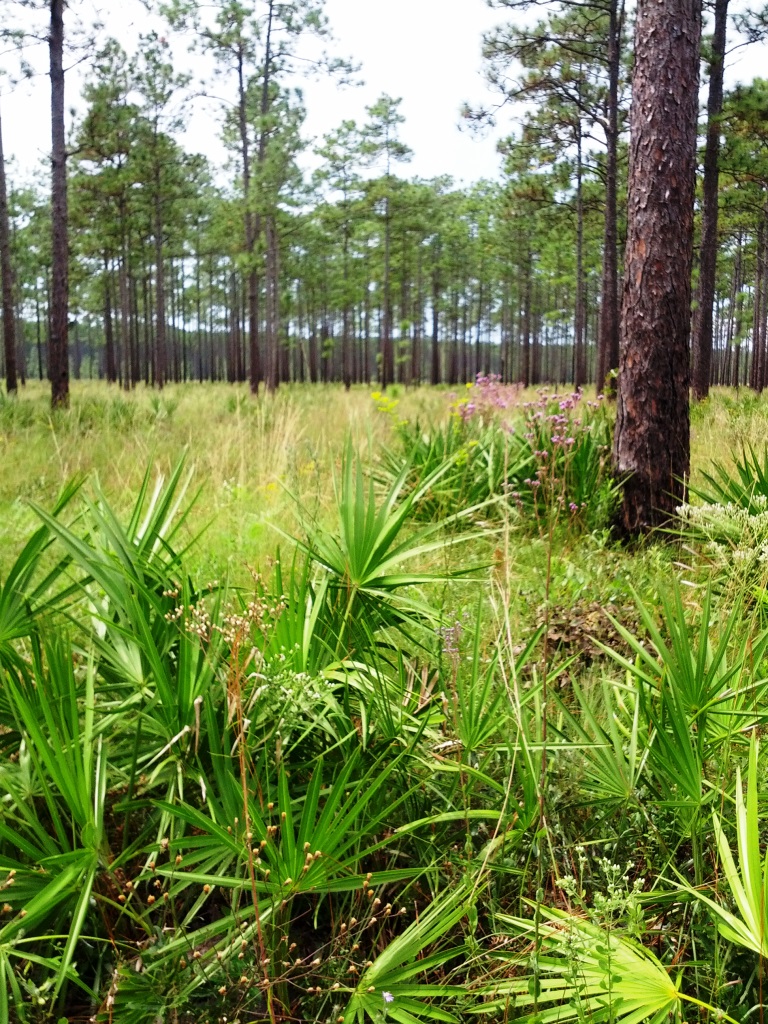
Woodlands and rangelands are important to both our economy and environment. Photo by Judy Ludlow
Most of us living in panhandle Florida recognize that our farmers and ranchers are committed to sustainable production of food, fiber, and fuel for generations to come, but how will farmers continue to be productive while sharing natural resources with an ever growing population and an intricate environment? How will Florida’s agricultural lands, rangelands, and woodlands continue to contribute to the quality of our environment and to our economy?
Florida Rangelands:
According to the USDA Natural Resources Conservation Service “Range and pasture lands are diverse types of land where the primary vegetation produced is herbaceous plants and shrubs. These lands provide forage for beef cattle….and other types of domestic livestock. Also many species of wildlife…depend on these lands for food and cover.” Florida’s rangelands and woodlands are a significant component of Florida’s agricultural industry.
According to the 2012 Census of Agriculture there were:
- 3,749,647 acres of permanent pasture and rangeland in Florida
- 1,368,171 acres of pastured woodland in Florida
Benefits of Rangelands:
Florida’s 5.1 million acres of agricultural rangelands and woodlands not only support the economy, but abundant wildlife too. These well managed lands are living systems sustaining livestock, wildlife, and healthy soils. Benefits of these lands include important economic and ecological services like reducing our carbon footprint, increasing water conservation, providing forage for livestock, habitat for wildlife and game, preservation of cultural heritage, and sustainable timber. Additionally, hunting, fishing, and wildlife viewing is a multi-billion dollar industry within which Florida’s rangelands play a significant role. Florida’s rangelands are also important for the continued survival of many threatened species like the Crested Caracara, Snail Kite, Gopher Tortoise, Florida Scrub-Jay, Eastern Indigo Snake, Roseate Spoonbill, Wood Stork, and Sandhill Cranes.
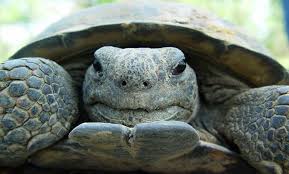
Gopher Tortoise. Photo by Chuck Bargeron, University of Georgia, Bugwood.org
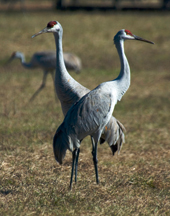
Sandhill Cranes in a North Florida pasture. UF/IFAS Photo by Josh Wickham.
Challenges to Florida’s Rangelands:
Threats to Florida rangelands include conversion into urban areas and fragmentation of large tracts of lands causing disconnection from other farmlands and natural areas. Contiguous, connected “wildlife corridors,” are important for many species of wildlife. Additionally, the establishment of non-native, invasive animals and plants; and alterations of natural and necessary processes such as fire, floods, and droughts, can disrupt the full economic and environmental potential of these lands.
Agricultural Best Management Practices and Education:
Today’s farmers use best management practices (BMPs) relying on up-to-date technologies and research to protect Florida’s unique natural resources, especially our precious water, while at the same time maximizing their production. BMPs are based on University of Florida Institute of Food and Agricultural Sciences (UF/IFAS) research and are practical, cost-effective actions that agricultural producers can take to conserve water and reduce the amount of pesticides, fertilizers, animal waste, and other pollutants entering our water supply. They are designed to benefit water quality and water conservation while maintaining or even enhancing agricultural production. According to the Florida Department of Agriculture and Consumer Services, for example, agricultural producers save 11 billion gallons of water each year by their conservation practices.
Many of Florida’s rangeland and woodland owners also take advantage of educational programs available to them such as the UF/IFAS Forest Stewardship Program. The mission of this multi-agency program is to help and encourage private landowners to manage their lands for long-term environmental, economic, and social benefits. According to their annual report: “In 2014 the Program reached 503 landowners and professionals directly with workshops and field tours. These landowners and professionals collectively own and/or manage over 2 million acres across Florida.”
Summary and Additional Resources:
Florida’s agriculture producers are deeply committed to being stewards of their lands and our surrounding environment. Their adoption and support of best management practices as well as continuing education is critical for sustainable production and also for feeding the world of the future.
For more information on this topic please see the following resources:
UF/IFAS Forest Stewardship Program
UF/IFAS Extension – Range Cattle Research and Education Center
UF/IFAS Extension – Best Management Practices
Florida Farm Bureau’s County Alliance for Responsible Environmental Stewardship Program (This Farm CARES)
Florida Department of Agriculture and Consumer Services – Best Management Practices
The Nature Conservancy – Florida Ranchlands
Food and Agriculture Organization of the United Nations – Grasslands and Rangelands
USDA Natural Resources Conservation Service
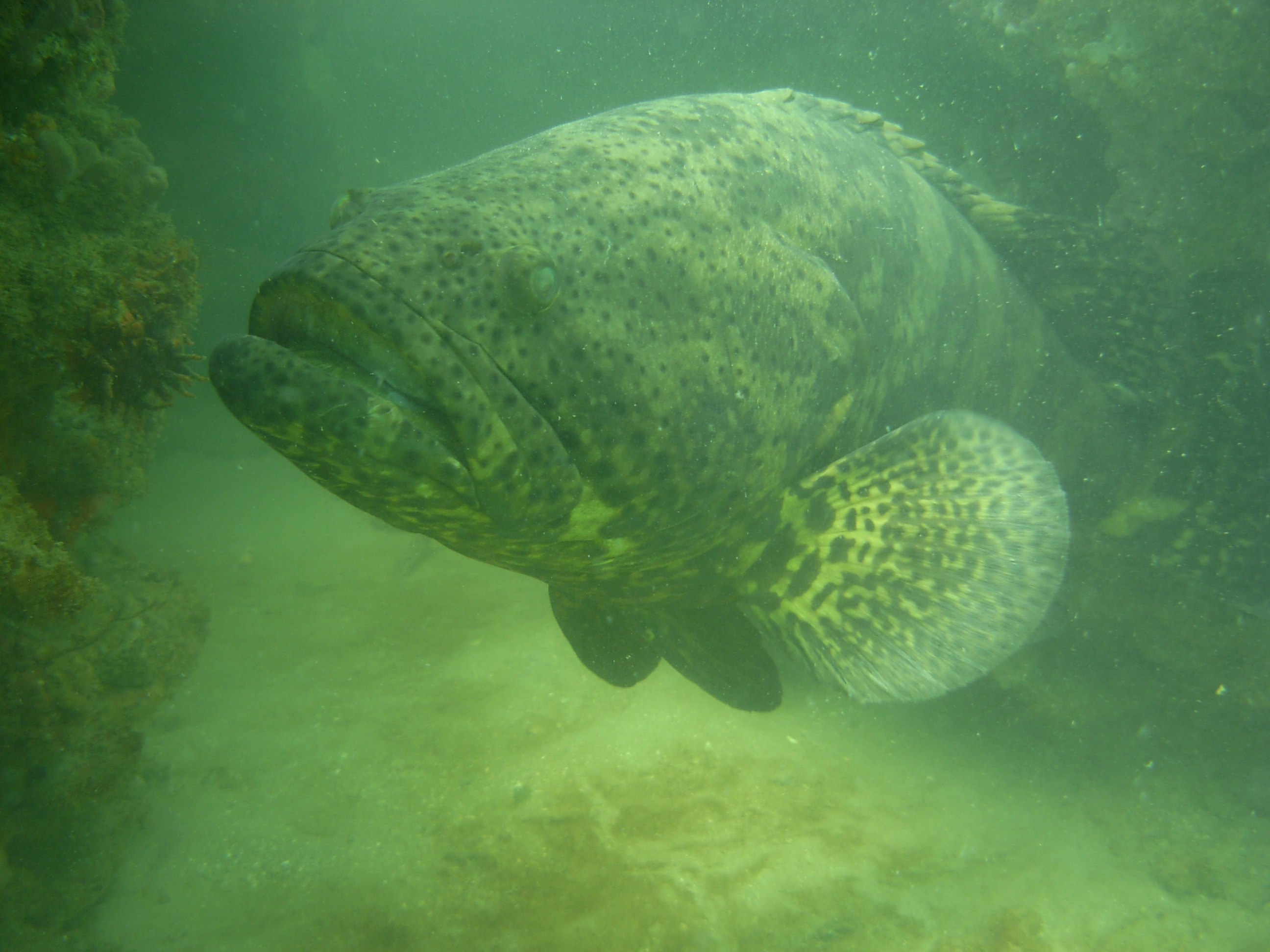
by Rick O'Connor | Jun 5, 2015
For many who are seafood lovers there is nothing like a good grouper sandwich; makes me hungry just to write that. Groupers are members of the one of the largest families of fish in the Gulf of Mexico. There are 33 species in the family Serranidae, which include sea bass and perch, and many are sold as “grouper” in the seafood markets. There are 10 species of searranids that are in the genus Epinephelus and are considered the true groupers. One of these, Epinephelus itajara , is a monster; this is the Goliath Grouper.
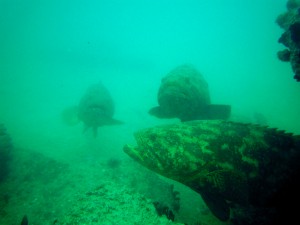
Three goliath groupers over wreck in southwest Florida. Photo: Bryan Fluech Florida Sea Grant
As the name states, these fish can reach 6 feet in length and over 700 lbs. Goliath groupers are generally found on structure such as artificial reefs, near drill platforms, and on natural bottom. They tend to stay near the reefs they inhabit but will travel long distances for breeding. Data suggest that the highest concentrations of these fish are in southwest Florida but they disperse across the Gulf and along the Atlantic coast of south Florida. The large spawning aggregations occur offshore, generally from July through September, and the planktonic larva drift into the mangrove estuaries of southwest Florida. Here the young fish live for 5-6 years feeding on the abundance of food found there and then head back offshore searching for reefs to call their own. Many head to the northern Gulf and our area. Though they are large they feed relatively low on the food chain, consuming primarily crustaceans and slow moving reef fish.
They were a huge trophy fish back in the middle 20th century. Fishermen could not resist the chance to have a photograph with one of these behemoths. Because of this popular activity, and the loss of their mangrove nursery grounds due to development, their numbers diminished across the state and today there is a “no harvest” rule for the fish. However some divers are indicating their numbers are increasing and that the Florida Fish and Wildlife Conservation Commission should to revisit the rule.
In response FWC’s research group, Fish and Wildlife Research Institute, in St. Petersburg conducts an annual “Goliath Grouper Count”. Modeled after the Christmas Bird Count conducted each year by the Audubon Society, the Goliath Grouper Count occurs during the first week of June. The counts have been occurring in south Florida for a couple of years but for the first time the panhandle will be participating this year. If you are a diver and interested there is a particular protocol that needs to be followed when counting. You can find out more by contacting Rick O’Connor in Pensacola at (850) 475-5230 or Scott Jackson in Panama City at (850) 764-6105 to obtain the protocol and the data sheets. The official count will run between June 1 and June 15.

by Rick O'Connor | May 29, 2015
This month there were many more plants flowering… it is true that April showers do bring May flowers. May not only brings more flowers but more tourists. Everyone is out enjoying the weather, including some wildlife. I was happy to include Florida Master Naturalist Paul Bennett on this hike and he was very helpful identifying plants. Thanks Paul!

Tent set up on Pensacola beach to protect from the sun. Photo: Rick O’Connor
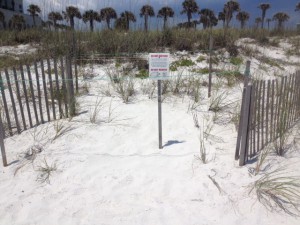
Sign altering and educating folks that this is a sea turtle nest. Photo: Rick O’Connor
It is sea turtle nesting season all along the Florida Panhandle. The season begins in May and ends in October. This time of the season the females are heading up the beach looking for good nesting locations near dunes. There are five species of marine turtles that inhabit the northern Gulf and there are records of each species nesting here. They emerge at night and move towards the dunes where they excavate a deep cavity to lay about 100 eggs. The nest is covered and she returns to the water. The incubation period is between 60-70 days and the temperature of the nest determines the sex of the hatchling; the warmer eggs becoming females. It is illegal to disturb a sea turtle nest.
This tent was occupied when I was there but all too often they are left overnight so folks can return the same spot the following day. Tents and chairs are barriers for both nesting females and emerging hatchlings. If at all possible, remove these for the evening. In some counties it is required. Another problem is artificial lighting. Adult turtles are distracted, and many times abort the nesting activity due to bright lights. Most panhandle counties have a lighting ordinance that requires homes to use turtle friendly lighting. To learn more about the turtle friendly lighting program and local ordinances contact your county Sea Grant Agent at the local Extension office or visit http://myfwc.com/wildlifehabitats/managed/sea-turtles/lighting/.
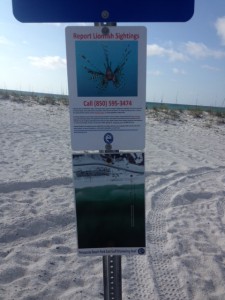
This county sign marks a public snorkel reef and also educates everyone about lionfish. Photo: Rick O’Connor
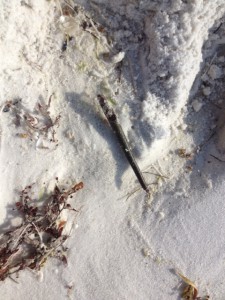
Mangrove seed washed ashore. Photo: Rick O’Connor
Summer means swimming and in many local counties there are interesting snorkel reefs nearby. We asked that everyone keep an eye out for the invasive lionfish as they enjoy their day. If one is spotted be aware they do have venomous, though not deadly, spines and please contact your local Sea Grant Agent at the county Extension office to let them know. If you are in Escambia County you can log your sighting at www.lionfishmap.org and FWC has a lionfish app for reporting; http://myfwc.com/news/news-releases/2014/may/28/lionfish-app/
The seed is of a red mangrove tree. These are common coastal plants in south Florida and elsewhere in the tropics. The red mangroves drops their seeds (propagules) into the water to drift in the currents to new locations. They frequently wash upon our shores and sometimes take root, but they do not last during our colder winters.

This Whitlow-Wort, also known as “square flower”. Common dune plant. Photo: Rick O’Connor
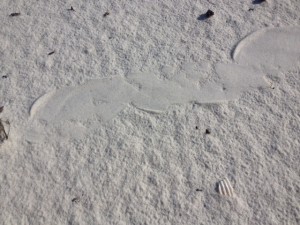
Track of an unidentified snake crossing a dune. Photo: Rick O’Connor
The flower to the left is the Whitlow-Wort, or as some locals call it… “square flower”. The track is of a snake but could not find it so I am not sure which species. The weather warms quickly here along the Gulf coast. A few months ago we may have been able to find this animal but with the increasing heat they were in a cool place somewhere. Snake encounters this time of year are typically at dawn and dusk.
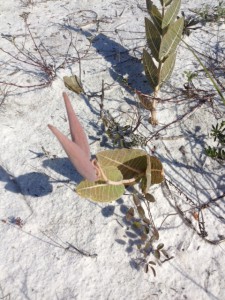
The seed pod of a milkweed. Photo: Rick O’Connor

An open seed pod of a milkweed releasing seeds. Photo: Rick O’Connor
The milkweed bloomed a few months ago but here in May we find both the seed pods and, in the photo to the right, the “dandelion-like” seeds being released. This is one of the plants used by the migrating monarchs, which we should see later in the year.
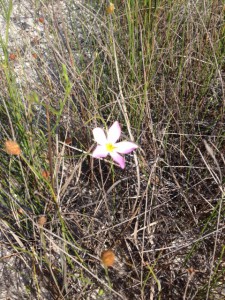
Marsh Pink, a flower found in the wetter areas of the island.
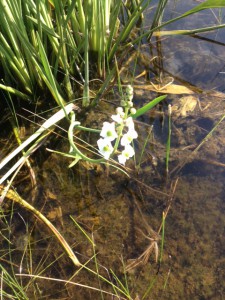
Narrow-leaved Sagittaria. Another water loving plant.
Here are two of the many flowers we saw today. Both of these were found in the freshwater ponds located in the swale areas of the barrier island. The flower to the left is known as Marsh Pink. The one to the right is Narrow-leaved Sagittaria.
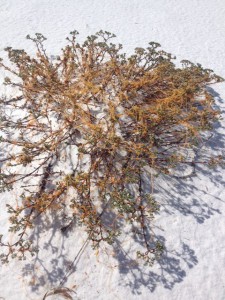
The yellow vine called “Love Vine”; correct name is Dodder.
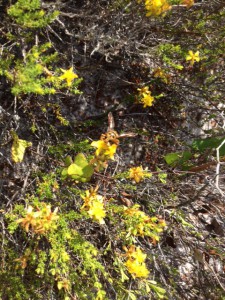
It is good to see bees on the island.
This orange-yellow stringy vine is called “Love Vine” but there is not much love here; this is a parasitic plant called Dodder. This is the first we have seen of it this year and expect to see more. Many residents on the island believe it to be an non-native invasive plant but it is actually a native and quite common out there. I have also seen it in the north end of Escambia County.
We did see a few bees today and this is a good sign. There have been reports in recent years of the decline of our native bees and the impact that has had on gardening and commercial horticulture. In addition to seeing bees Paul and I also came across the famous yellow fly. These were encountered near the marsh on the sound side of the island. Loads of fun there!

The “bed” made by an unknown animal that has been frequenting this location all year. Photo: Rick O’Connor
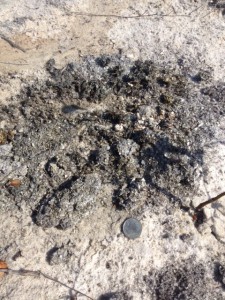
This scat pile was near the location of the “bed” and along the drag marks made by this animal.
If you have been following this series since we began in January you may recall the strange “bedding” and drag marks we have encountered near the marsh (you can read other issues on this website). I have seen these drag marks, and apparent bedding areas, every month except last. I showed them to Paul and we are still not sure what is making them. Again, whatever it is seems to move from one body of water to another. We cannot find in foot tracks to help identify it… but we will!
The photo to the right is of a large scat pile approximately 15-16” across. It was relatively fresh and contained crab and shrimp shell parts. Not sure if it was left by the same animal that continually makes the drags but was in the same location so…
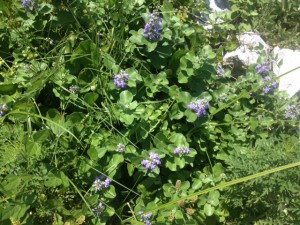
The pretty, but invasive, beach vitex. Photo: Rick O’Connor
Many of the plants on our barrier islands are blooming now, and so is this one. This is Beach Vitex (Vitex rotundifolia). It is an invasive/not-recommended plant. Currently we are only aware of 22 properties in Escambia County that have it. Sea Grant is currently working with the SEAS program at the University of West Florida to assist in removing them. If you believe you have this plant and would like advice on how to remove contact your local Sea Grant Agent at the county Extension office.
Let’s see what shows up in June!

by Erik Lovestrand | May 29, 2015
![Life Stages of the True Jellyfish: Photo: By Matthias Jacob Schleiden (1804-1881) [Public domain], via Wikimedia Commons](https://nwdistrict.ifas.ufl.edu/nat/files/2015/05/Schleiden-meduse-2-202x300.jpg)
Life Stages of the True Jellyfish: Photo: By Matthias Jacob Schleiden (1804-1881) [Public domain], via Wikimedia Commons
“Ouch, something just stung me.” This is a common phrase to hear someone say (I’ve heard myself say it) while enjoying the otherwise soothing waters along our beautiful Gulf Coast. We host an amazing variety of marine organisms that possess the ability to sting when contacted. I’m referring to organisms in the phylum Cnidaria (pronounced “ni-dair-ee-ah”), which includes about 10,000 species that have been identified. There is general agreement on the classification of five different classes of cnidarians, all of which have stinging cells, but most of which are not dangerous to humans. These include Class Anthozoa (anemones and corals), Class Cubozoa (box jellyfish), Class Scyphozoa (true jellyfish), Class Staurozoa (stalked jellyfish) and Class Hydrozoa (hydroids i.e. Portuguese man o’ war). I’m always intrigued by the origin of scientific names so here is a slight tangent for you on the group names (Cnides: from the greek meaning nettle)(Antho: flower-like; Cubo: cube-shaped; Scypho: cup-shaped; Hydros: sea serpent; Stauro: cross-shaped). The term “zoa,” of course, refers to animals.
Most of the time you are stung in our local waters it involves the classes Hydrozoa or Scyphozoa. The Hydrozoans are a complex group of organisms but most species go through two distinct stages during their life cycle. The hydroid stage takes the form of a polyp which is composed of a stalk and tentacles at the end. Polyps can be single but are often colonial, connected by tube-like structures. Most polyps are specialized for feeding but others are used to reproduce. Reproductive polyps lack tentacles but have many buds which form the medusa stage of the organism for reproduction purposes. Medusae of the hydroids are similar in design but typically smaller than the medusae of the true jellyfish. Some hydroids also have specialized defensive polyps with numerous stinging cells and one species even has a specialized polyp that develops into a large balloon-like float that the others attach to (the man o’ war). There is one specific type of hydroid in our area that closely resembles a piece of branching brown algae, such as Sargassum. The polyps are scattered along the branches and when brushed against they fire their nematocysts (stinging cells) producing a painful sting. The burning sensation can last for several minutes and you would have sworn the only thing around you was a harmless piece of drift algae.
The true jellyfish, of Class Scyphozoa, also go through a polyp and medusa stage. The polyps of this class are typically single and settle to the bottom as larvae and attach themselves. Over time the polyps mature and produce other polyps by budding, or bud medusae off their upper surface. These jellyfish medusae are microscopic at this stage and many take years to reach maturity, complete with a cup-shaped (scypho= cup shaped) bell and tentacles hanging beneath.
The subsequent lives of these translucent marine creatures is no less intriguing than the processes involved in their development. Check out this website from the Smithsonian for more great information. The next time you feel the burn of a host of nematocysts injecting you with their potent venom, I dare you to stop for just a second to be amazed by the fascinating creature that you have just met. If you can pull this off you are well on your way to becoming the quintessential nature nut! Click here for helpful information if you are stung.
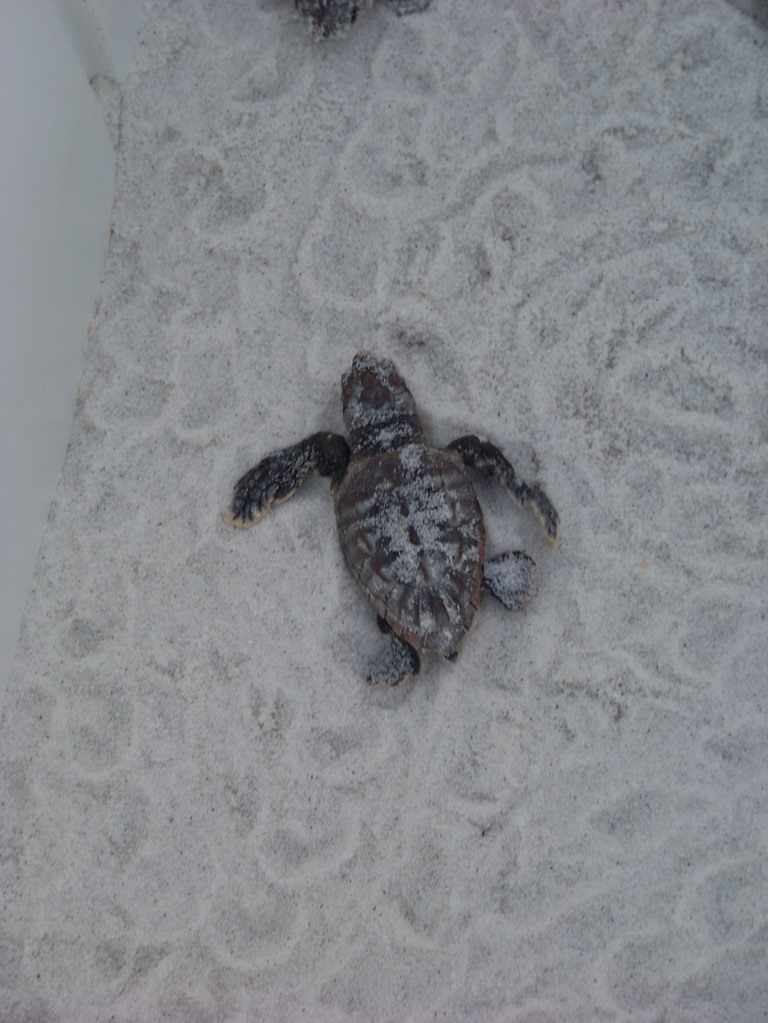
by Rick O'Connor | May 10, 2015
It is May and this is the official beginning of the sea turtle nesting season. These ancient creatures have followed this nesting cycle for centuries traveling the open ocean, feeding and resting on reefs, then returning to shore in the spring and summer to breed and lay their eggs on beaches and barrier islands. What is neat is that Dr. Archie Carr discovered they return to the same beaches near where they were born. So those visiting our beaches are in a sense, “our” turtles. Another interesting fact about panhandle sea turtles is that a significant number of male turtles are produced here. Gender in most turtles is determined by the temperature of the egg during incubation in the sand; colder temperatures producing males. Since the panhandle has cooler temperatures than the lower peninsula of Florida, we produce the majority of the males for our populations. This is also why we have fewer nests than south Florida, since it is the females who return to shore.
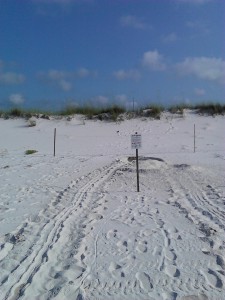
Tracks left by a nesting Green Sea Turtle. Courtesy of Gulf Islands National Seashore.
However, in the last 50 years more and more people have moved to the beaches and barrier islands of the panhandle and the sea turtles have run into problems continuing their ancient cycle. Four of the five species of sea turtles in the Gulf of Mexico are currently listed as endangered; the loggerhead is listed as a threatened species. Though they have issues with natural predators much of their trouble is due to human activities. HERE ARE FIVE THINGS YOU CAN DO TO HELP SEA TURTLE NESTING THIS SEASON.
- Offshore, more and more turtles are being struck by boats. These are air breathing reptiles and need to surface. Unfortunately nesting season is also during the height of fishing and diving season. Many boaters must follow no wake zones to reach open waters and want to open up the throttle when they do. As with manatees in our rivers we ask that you keep a lookout for the surfacing heads as you are heading to and from your destination.
- Both offshore and inshore sea turtles are encountering more plastics in the marine environment. Turtles become entangled in discarded fishing line and actually consume many forms of plastic debris drifting in the water column. One loggerhead found on Dauphin Island had 11 pounds of plastic lodged in its esophagus, which obviously kept it from feeding properly. When you go boating please develop some method of storing plastics and fishing line until you reach shore. Once you return to the boat ramp please use the fishing line recycle bins to discard your fishing line. Fishing line placed in these are recycled into new fishing line. If there is not a fishing line recycle bin at your boat ramp contact your County Sea Grant Agent to see if one can be placed there. If you are enjoying the beach from shore please discard of all solid waste in trash or recycle cans before leaving.
- On the beach many residents and visitors spend the day playing in the sand and building sand castles. This time long activity is great fun but leaving large holes in the sand when you leave has not only entrapped turtles but have been problems for turtle watch and safety vehicles using the beach. Please fill in your holes before you leave for the day.
- Another issue on the beach are chairs and tents left over night. Many residents and visitors staying on the beach for a week or longer like to keep their chairs and tents set up for the duration. However this has caused barrier, and sometimes entrapment, issues for the turtles. We ask all to remove these from the beach at the end of the day.
- And finally, the lights. 40-50% of our turtle nests in Escambia County are disoriented by artificial lighting. Most panhandle counties do have beach lighting ordinances. We ask both residents and visitors to become familiar with their ordinances and abide by them. Exterior lighting should be low to the ground, long in wavelength (yellow or red), and shielded to direct the light down. Interior lighting can be blocked by closing the shades, moving the light source away from the window, or simply turning them off. All counties’ ordinances have some version of these basic ideas.
With a little help from us, our sea turtles can continue their ancient cycle. These animals are fascinating to see and for many, the highlight of their trip to the beach. If you have questions about sea turtle biology or the local lighting ordinances contact your Sea Grant Agent at the county extension office.
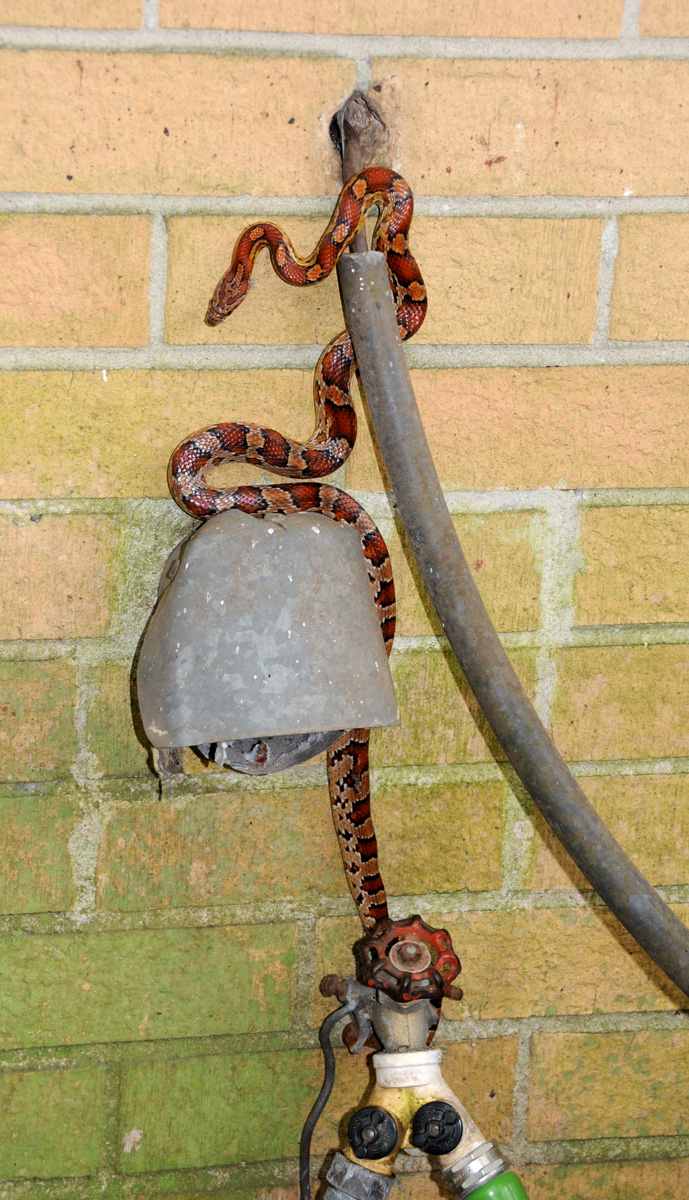
by Rick O'Connor | Apr 24, 2015
This rhyme has been around for decades suggesting that rain increases during the month of April. In recent years the amount we have received has caused local flooding, and most in Escambia County will remember receiving 26” of rain in 24 hours! These heavy localized rain events have certainly removed pollen from the air but they have also dropped blossoms from plants, dropped baby birds from their nests, forced fire ants to surface and move to high ground, and then there are the snakes.
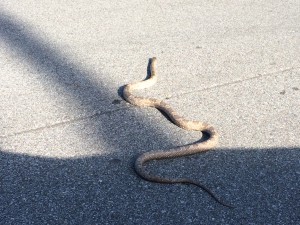
Gray rat snake crossing a driveway.
Photo: Carrie Stevenson
It was actually these flooding events that developed the need for the snake program I am currently doing for Extension. Highly saturated ground forced the snakes to search for high ground. Patios, driveways, garages, and occasionally bathrooms, became popular places for the reptiles to dry off. In the last week or two I have had calls about snakes in buses, on bushes, and in the laundry room, and I actually met someone at a restaurant to identify what kind of snake they found in their home.
For many, it does not matter what kind of snake it is, they are all terrifying and dangerous and unwanted in the yard. For others, nonvenomous snakes are not welcome but they are not life threatening. Venomous snakes on the other hand… well that’s a different story. The problem here is that many do not know how to tell a moccasin from one of the water snakes. When you are not sure, you are more nervous than you may need to be. Venomous snakes truly bother people psychologically.
There are six venomous snakes in Florida and all six have been found in the panhandle. Five of these are members of the “pit viper” group and can be identified by their triangular shaped head, elliptical pupil in the eye, and a heat sensitive pit in front of their nostril. Most venomous snakes also have a dark colored “mask” (stripe) across their face. It is the mask character that I look for first, because many nonvenomous snakes flare their head when threatened and you have to get close to check the shape of their pupil. The pit vipers include the Copperhead, Moccasin, Pygmy Rattlesnake, Timber Rattlesnake, and the Eastern Diamondback. The non-pit viper is the Eastern Coral Snake. Each of these snakes should be considered dangerous and handled only by a professional if in your home. Remember, 95% of the people bitten by venomous snakes are either trying to catch or kill them.
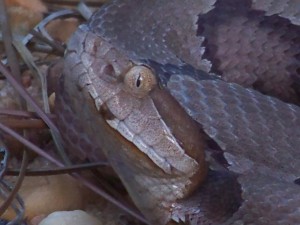
The head of a pit viper. Notice the additional pit, elliptical pupil, and “mask” across the eye. Photo: Molly O’Connor
There are several methods you can use to reduce the chance of an encounter in your yard or home, and Extension would be glad to help with these. But remember, you live in Florida and snakes are part of the landscape here. Also remember there are four snakes in the panhandle that FWC staff are tracking: the Florida Pine Snake, Southern Hognose, Eastern Indigo, and the Eastern Diamondback. If you do encounter any of these visit http://myfwc.com/conservation/you-conserve/wildlife/snakes/ to log a report and include a photograph and GPS location if possible. If you have any questions about snake encounters contact your county Extension office.























![Life Stages of the True Jellyfish: Photo: By Matthias Jacob Schleiden (1804-1881) [Public domain], via Wikimedia Commons](https://nwdistrict.ifas.ufl.edu/nat/files/2015/05/Schleiden-meduse-2-202x300.jpg)




